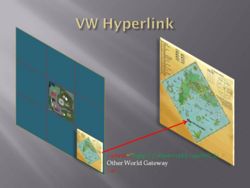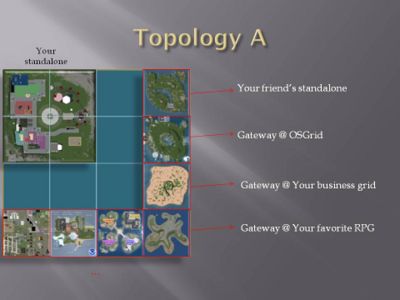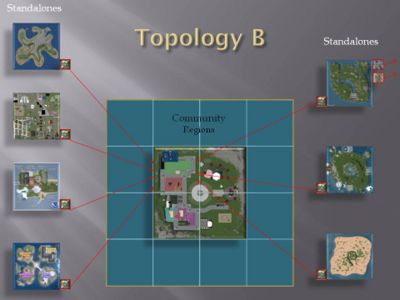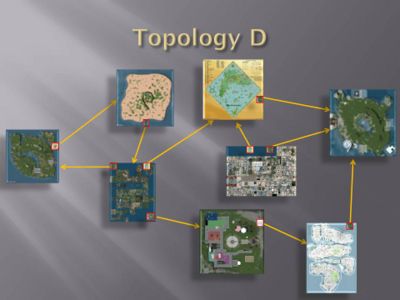Hypergrid
From OpenSimulator
(→What is the hypergrid?) |
|||
| Line 4: | Line 4: | ||
== The OpenSimulator Hypergrid == | == The OpenSimulator Hypergrid == | ||
| − | |||
=== What is the hypergrid? === | === What is the hypergrid? === | ||
| Line 112: | Line 111: | ||
Please see [[Banning Foreign Users in Hypergrid]] | Please see [[Banning Foreign Users in Hypergrid]] | ||
| − | |||
== Public Hypergrid Nodes == | == Public Hypergrid Nodes == | ||
Please see [[Public Hypergrid Nodes]]. | Please see [[Public Hypergrid Nodes]]. | ||
| − | |||
== Hypergrid Lists == | == Hypergrid Lists == | ||
Please see [[Hypergrid Lists]]. | Please see [[Hypergrid Lists]]. | ||
| + | == Further References == | ||
| + | * http://www.ics.uci.edu/~lopes/opensim/HypergridReferenceGuide.html | ||
== Development Meetings == | == Development Meetings == | ||
Revision as of 09:46, 13 June 2013
The OpenSimulator Hypergrid
What is the hypergrid?
The hypergrid is an extension to opensim that allows you to link your opensim to other opensims on the internet, and that supports seamless agent transfers among those opensims. It can be used both in standalone mode and in grid mode. The hypergrid is effectively supporting the emergence of a Web of virtual worlds.
The basic idea for the hypergrid is that region/grid administrations can place hyperlinks on their map to hypergrided regions run by others. Once those hyperlinks are established, users interact with those regions in exactly the same way as they interact with local regions. Specifically, users can choose to teleport there. Once the user reaches the region behind the hyperlink, she is automatically interacting with a different virtual world without having to logout from the world where she came from, and while still having access to her inventory.
The hypergrid started as a GForge project, but it is now included in the standard distribution of OpenSimulator. To run your OpenSimulator instance in hypergrid mode, please see Installing and Running Hypergrid.
Hypergrid Versions
- Hypergrid 2.0 - current Hypergrid with greater security controls for region operators
- Hypergrid 1.5 - past Hypergrid version with greater asset security and expanded services
- Hypergrid 1.0 - the original Hypergrid described below
Virtual World Hyperlinks
We're all familiar with hypertext links on the Web. But what is a virtual world hyperlink?
In the hypergrid model, we consider the 2D map of the virtual world as the equivalent of a web page. As such, a VW hyperlink is simply a region on that map.
The default model of opensim-based virtual worlds already supports this concept of hyperlink, to some extent. When you teleport from one region to another via the map, chances are you are migrating your agent into a different opensim server. This migration is a glorified "agent transfer" that also exists, in rudimentary form, on the web when hypertext links are followed. The default model, however, imposes two very strong constraints on these hyperlinks:
- The entire map of regions is controlled by a central service known as the grid service, whose job is to provide a uniform view of the world to all of its regions.
- The only agents that can be transferred are those pertaining to users known to another central service, the user service; if the incoming user is not on that service's database, the agent transfer doesn't go through.
The hypergrid simply removes these two constraints.
First, it allows individual opensim instances to add "neighbors" to their local map, shifting the control of the map down from the grid server to individual opensim instances (although hyperlinks can also be served by grid servers if grid admins so wish). In doing so, the world becomes a lot more interesting and varied. The map that you see in one opensim instance may be completely different from the map that you see after you teleport via an hyperlink. As an opensim administrator, you are free to define what other opensims you want to see on your map.
Second, it allows the transfer of agents pertaining to foreigner users, i.e. users who are registered elsewhere. Instead of assuming one central user service, the hypergrid assumes an arbitrarily large number of such services distributed all over the world. As such, when agents are transferred among hypergrided opensims, a lot more information is passed about the corresponding user. That information includes the collection of servers that the transferring user needs.
Usage Scenarios
The following are some usage scenarios. There isn't a clear separation between these scenarios, there's a large overlap between them. This is also not an exhaustive list. The purpose of these descriptions is to give you some starting ideas for how to use the hypergrid in practice. Please feel free to add other interesting scenarios to this list.
|
Personal Worlds This first scenario pertains to standalone opensims. Normally, standalones are completely disconnected from the internet. However, when run in hypergrid mode, standalones become network-able. As such, you can run your own world in your own computer, and link your world to whoever you want. For example, you can link to your friends' hypergrided opensims and to hypergrid gateways in open grids such as OSGrid. The great thing about this scenario is that all of your assets are stored on your computer, and not on somebody else's server. You can back them up using ordinary backend tools. The not so great thing about this scenario is that all of your assets are stored on your computer! If your disk goes berserk, you loose them. (so make sure you make external backups regularly) | |
|
Communities This second scenario is about communities, broadly construed. The idea here is that a group of people come together to support a small community grid, i.e. a common world where shared activities take place. But at the same time, the members of the community maintain their own standalone worlds. The standalones link to the community grid, and the community grid may link back to the individual members' worlds and other places of interest. The members' identities are probably the identities they have on their standalones, and their assets are also probably stored there. The assets present in the community regions, however, are stored on the grid asset server. | |
|
Grid Public Regions Walled-gardens are here to stay, and they serve many useful purposes. There is a hybrid mode for the hypergrid that some walled-garden grid operators may be interested in supporting. In this hybrid mode, most opensim instances on the grid run in normal, wall-garden mode, so no foreign visitors are allowed there - technically it is impossible to reach them. However, a few opensim instances on that grid can run in hypergrid mode, so that foreign visitors are allowed. This way, there is a gateway for grid-local users and arbitrary visitors to meet. This is also a good strategy for attracting new users to the grid, since random users are able to visit those gateway regions without having to sign up for an account upfront. This hybrid mode is very similar to what happens on the web. For example, anyone can visit Facebook's public pages without having to sign up for a Facebook account. However, only Facebook users can go further inside. | |
|
Level Games The normal version of OpenSimulator enforces a common map for all the regions on a grid. The hypergrid removes that constraint. As such, it becomes easy to design VW games where the world looks different depending of where the player is. |
Hypergrid Implementation
Hyperlinks and Agent Transfers
When you establish a link between your opensim and another, a message is sent out to that other opensim requesting information about it; the required information includes the network information of that opensim host, and the coordinates of its first region on its local grid in the form of a region handle. For example, suppose you are linking node X.com:9000, placing it in your local map at 900, 900. That opensim runs one or more regions that likely are not in 900, 900 on their own map; suppose the first region of that opensim is at 1100, 1100. From your point of view, it doesn't matter what those other coordinates are, and you don't need to know -- that's the key to being able to decentralize the "world" as given by a 2D map; you want to place it in your map at 900, 900. The "true" position of that simulator only matters for the LL viewer, when there are teleports between your world and that other opensim. This mapping between coordinate systems is the essence of hyperlinks for opensim; it's one simple but critical thing that the hypergrid implementation does. The mapping happens on the TeleportFinish event; instead of sending the local coordinates to the viewer, the hypergrid teleport wrapper sends the remote coordinates.
When an agent teleports through that hyperlink the following happens. First, before InformRegionOfChildAgent, the local opensim notifies the remote opensim of this foreign user via the "expect_hg_user" method. That message sends along the addresses of all the servers that this user uses, i.e. user, inventory and asset servers. The remote opensim places an entry for that user in its local user profile cache but not in its user database; the foreign user information is non-persistent. After that, the teleport process is exactly the same as the normal teleport process; the only difference is that the region handles are switched between the remote region's hyperlink position on the local grid and its actual position on its grid.
In summary, the two new concepts introduced by the hypergrid are the concept of an hyperlink and the concept of a "local user" vs. "foreign user".
Inventory Access
Inventory access from abroad is done by wrapping the existing scene-inventory interactions with additional code that gets or posts inventory assets from/to the user's asset server. When inventory is accessed, the hypergrid wrapper checks if the user is foreign and, if she is, the wrapper simply brings the necessary assets from the user's asset server to the local asset cache and server; from then on, the wrapper passes the control to the existing inventory access functions. When something is added to inventory, the hypergrid wrapper is notified via an event, and posts the assets to the user's asset server. A cache of the exchanged item identifiers is maintained so that they aren't brought back over and over again.
The result is that hypergrided opensim instances end up interacting with several asset servers, instead of just one. That interaction is implemented in a straightforward manner by instantiating several GridAssetClient objects, instead of just one.
Installing and Running
Please see Installing and Running Hypergrid
Hypergrid and Security
Please see Hypergrid Security
Banning Foreign Users
Please see Banning Foreign Users in Hypergrid
Public Hypergrid Nodes
Please see Public Hypergrid Nodes.
Hypergrid Lists
Please see Hypergrid Lists.
Further References
Development Meetings
See Also
Also see Grider; Virtual World Model; HyperGrid Team





